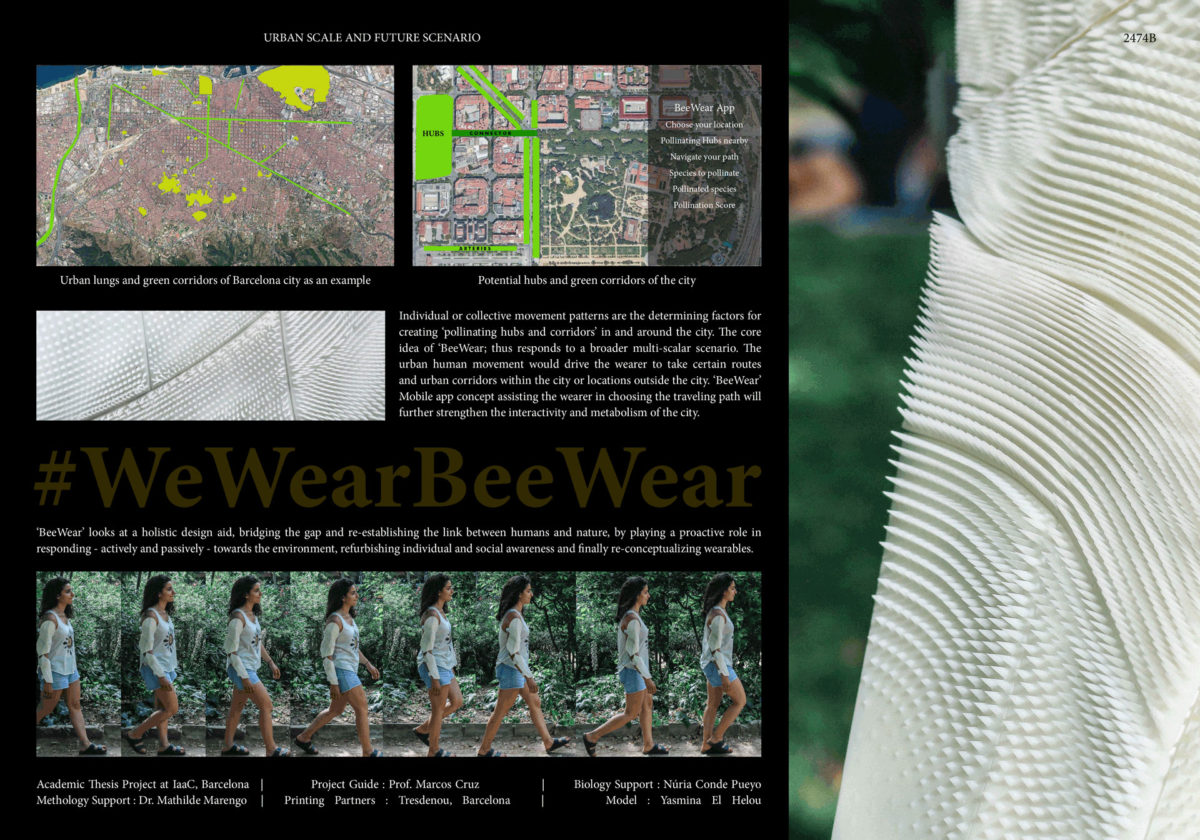RESHAPE19 | Cognified matter
Wearable technology category
BeeWear

The umbrella of wearables is a melange of clothes and accessories designed to cater the wearer.
Though majority of the contemporary wearables behave solely as an intermediate layer of protection and for accentuating visual creativity through fashion and trends; Contemporary technology has added a layer of performative concepts, accommodating information gathered by the external stimuli. Merging the lines of sustainability, technology, human engagement, and personal contribution towards their immediate environment; a unified design approach makes the
wearable a personal asset for the wearer.
In the Anthropocene of complex living systems and networks, behavioral phenomena play a crucial role in sustaining ecosystems and the livelihood of diverse, interdependent species. Interaction between these distinct species is an essential behavioral loop needed for survival and reproduction. Pollination is one such bilateral relationship between animals and flowering plants that help each other co-exist. Among all the known pollinators,’ bees’ are considered as one of the most effective and active contributors in the process of pollination. Decrease in their population due to multiple factors has led to an environmental imbalance globally, affecting not only the natural landscapes and agriculture on a large scale but also the Earth’s biological metabolism.
The research started by focussing on an environmental issue that can be aided and engaged with on a personal level and urban scale. As humans, we travel through multiple spaces and locations in a day or a week. We tend to choose our path from location ‘A’ to location ‘B’ or from ‘B’ to ‘C.’ Similarly, bees travel to specific areas, interacting with particular flowers for their dependency on nectar. The physical interaction between the bee and the flower helps the flower to deposit pollen on the bees. Bees in a single journey will always associate themselves with the same species of flower increasing the flowers potential to get pollinated. Though this is a physically intimate interaction, bees also collect a considerable amount of pollen while flying. Pollen, due to its scale and lightweight are present in the air in large quantities. A research carried out in the northeast United States suggest that human clothes are passive collectors of pollen, collecting up to seven million pollen on a T-shirt (5000sqcm) on peak pollen-producing days 1 . Thus this design project through research proposes a wearable concept – for humans – designed through the principles of biomimicry and its functionality that could potentially assist and aid pollination in urban areas
(cities), semi-urban regions, and natural habitats.

The concept of ‘BeeWear’ reflects its purpose concerning the pollination backdrop, drawing parallels between humans and bee navigation and travel behavior. The methodology is composed of studying bee morphology, a series of design iterations based on natural interaction and scale optimization, functionality, geometries, fabrication processes, and supplemental fashion aesthetics. It caters to a holistic design aid, bridging the gap and re-establishing the link between humans and other species, by playing a proactive role in responding – actively and passively – towards the environment, refurbishing individual and social awareness and finally rethinking about the envelope of wearables.
The economics of the printed wearable pieces depend on the density of hair, thickness, and heights combine. These add up to the total volume of material used. This material volume with the printing and cleaning time gives the total cost of the printed part(s). BeeWear currently consists of 9 pieces (upper arm) and 7 pieces (forearm) respectively. The existing design pieces fit within the base size of 140 x 70 mm. The average cost per piece – 14 euros. Concluding the stage one of the development, research is being carried forward to see the future design, materials, and fabrication possibilities.


